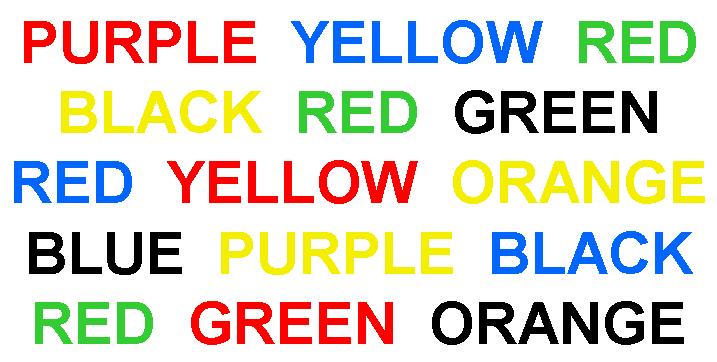THE STROOP EFFECT

J. Ridley Stroop
Named after J. Ridley Stroop, the Stroop Effect deals with issues surrounding selective attention. When presented with a word that is printed in its own color (ORANGE, BLUE, RED, etc), people have no issue naming the color of the words. However, when the color of the word does not match the meaning of the word (see figure), people take a longer time to name the color. In Stroop Effect experiments, the meaning of the word distracts the participant from being able to name the color of the printed word. J. Ridley Stroop called this "interference."
Since the publishing of Stroop's experiment, many researchers have done additional studies to try to explain the effect. Some researchers believe that this phenomenon can be explained by parallel distributed processing (PDP). In this approach, two different pathways are activated during the Stroop Effect task and this activation of both pathways causes interference. Another approach to explain this effect is the speed of processing model. This model suggests that interference occurs because adults read more often than they name colors. Processing and naming colors requires a longer reaction time than processing and reading words. Therefore, when trying to name colors, reading the words interferes with the task.

Example of Stroop Effect experiment
Related Links:
Background on the Stroop Effect
Find out the basics about J. Ridley Stroop's work and the processing models associated with the Stroop Effect.
Studies of Interference in Serial Verbal Reactions
J. Ridley Stroop's original paper published in the Journal of Experimental Psychology.
For Kids: The Stroop Effect
A kid-friendly link that explains the Stroop Effect and provides an interactive Stroop Effect experiment for kids to try.
The Reverse Stroop Effect
Frank H. Durgin's paper that tested a phenomenon called "The Reverse Stroop Effect."
A Special Case of the Stroop Effect: Kids may not be as different as we thought
This link compares Stroop Effect reaction times between children and adults. Is there any difference?
What can the Stroop Effect test for?
The Stroop Effect experiment has been used to test for ADHD, dementia, brain damage, etc.
Stroop Effect Demonstration
See how well you test on an online version of the Stroop Effect experiment.
The Stroop Effect and Schizophrenia
A scholarly article that tests and explains the relationship between the Stroop Effect and schizophrenia. Download the PDF to read the paper.
The Stroop Effect and Personality
An interesting scholarly work that tested how reaction times on the Stroop Effect related to the personality of the participant.
How the Stroop Effect has been adapted
An example of how the Stroop Effect has been modified over the years to test for interference.
This page was developed by Rebecca Clanton. If there are any issues with any copyright material on this page, contact Rebecca Clanton at 10778074@live.mercer.edu.
Comments (0)
You don't have permission to comment on this page.